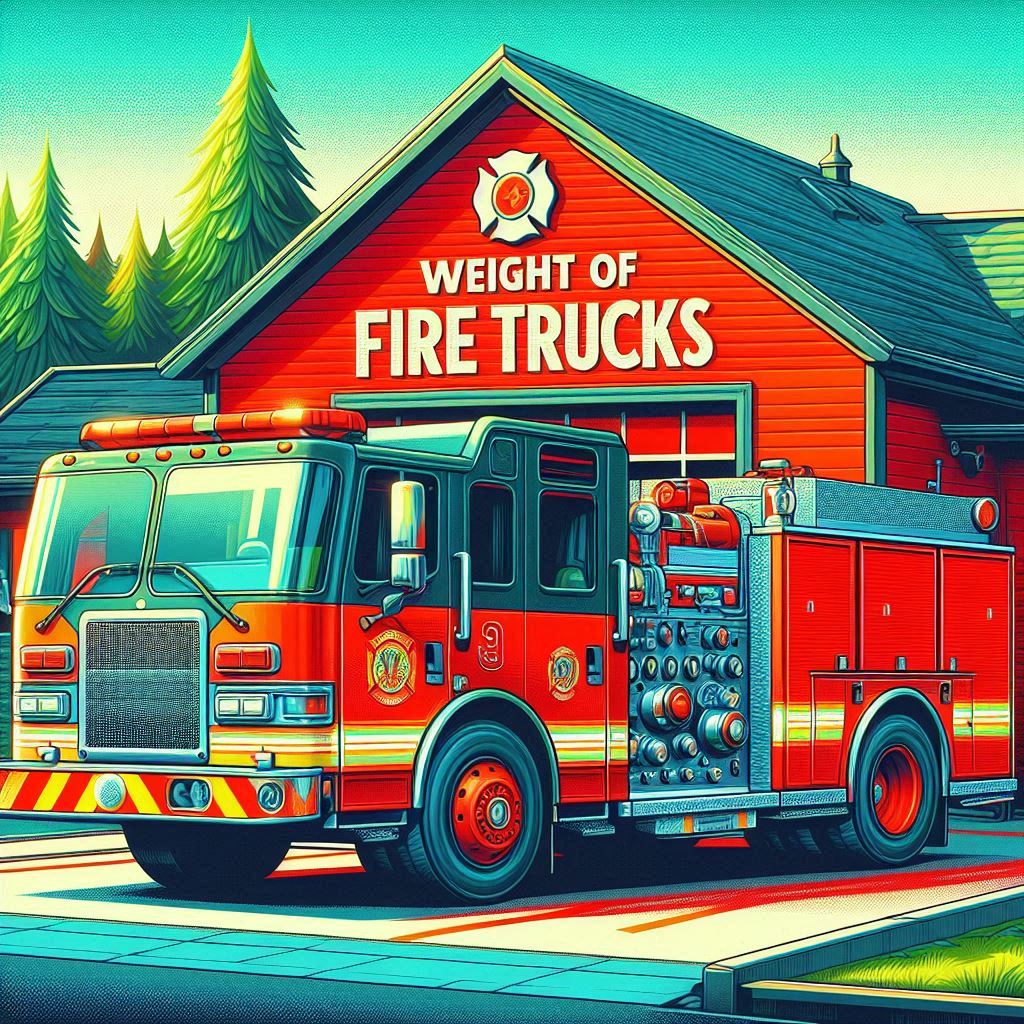
Curious about how much fire trucks weigh? In this detailed comparison, I’ll break down the weight variations of different types of fire trucks. From compact brush trucks to heavy-duty ladder trucks, each serves a unique purpose and comes with its own weight specifications.
Understanding the weight of fire trucks is crucial for various reasons, including transportation logistics, equipment capacity, and road safety. By delving into this topic, I’ll provide insights into the factors that influence the weight of fire trucks and how it impacts their performance on the field.
Join me as we explore the fascinating world of fire truck weights, uncovering the significance of these numbers in ensuring effective emergency response and firefighter safety.
Key Takeaways
- Different types of fire trucks serve specific purposes in firefighting and rescue operations, including pumpers, aerial trucks, brush trucks, rescue trucks, and tankers.
- Understanding weight specifications, such as for compact brush trucks and pumper trucks, is essential for fire departments to optimize response strategies based on agility, equipment capacity, and terrain considerations.
- Weight variations in pumper trucks, from light-duty to heavy-duty, impact water-carrying capacity, maneuverability, and overall performance.
- Heavy-duty ladder trucks, designed for reaching tall structures, typically weigh between 50,000 to 70,000 pounds, impacting stability, maneuverability, and equipment capacity.
- Factors influencing fire truck weight include size, equipment onboard, material construction, and specialized features, all crucial in selecting the right trucks for operational needs and safety compliance.

Types of Fire Trucks
When it comes to fire trucks, there isn’t a one-size-fits-all solution. Different types of fire trucks serve various purposes in firefighting and rescue operations. Here are some common types:
- Pumpers: These are versatile trucks equipped with water tanks, hoses, and pumps, used for tackling fires in urban and suburban areas.
- Aerial Trucks: These include ladder trucks and platforms that offer vertical reach for tall buildings or structures.
- Brush Trucks: Designed for off-road firefighting in wildland areas, they are compact and agile.
- Rescue Trucks: Equipped with specialized tools for extricating individuals from vehicles or confined spaces.
- Tankers: Carry large amounts of water to locations with limited or no water supply, crucial for rural firefighting.
Each type of fire truck has unique features and capabilities tailored to specific emergency scenarios. Understanding the differences between them helps fire departments optimize their response strategies based on the nature of the incident at hand.
Weight Specifications of Compact Brush Trucks
When it comes to the weight specifications of compact brush trucks, it’s essential to consider their agility and maneuverability in rough terrain. These specialized vehicles are designed to navigate through challenging landscapes to combat wildfires effectively. Here are some key points to note about the weight of compact brush trucks:
Average weight range:
Weight Category Weight Range
Light-duty 10,000 – 16,000 lbs
Medium-duty 16,000 – 26,000 lbs
Heavy-duty 26,000+ lbs
Factors influencing weight: The weight of a compact brush truck is influenced by various factors such as the chassis type, tank capacity, equipment onboard, and additional features like 4×4 capabilities.
Impact on performance: While a heavier brush truck may offer more carrying capacity for water and equipment, it can also affect the vehicle’s speed, agility, and fuel efficiency in rugged terrains.
Regulations and limitations: Fire departments need to adhere to weight regulations and restrictions imposed by authorities to ensure safety on roads and bridges while transporting compact brush trucks to emergency sites.
Understanding the weight specifications of compact brush trucks is crucial for fire departments to make informed decisions about their suitability for specific firefighting and rescue operations.
Weight Variations in Pumper Trucks
When it comes to pumper trucks, it’s essential to note that they vary significantly in weight based on their size and design. Pumper trucks are crucial in firefighting operations, carrying substantial amounts of water and equipment to the scene. Here, I’ll delve into the different weight variations you might encounter with pumper trucks:
- Light-Duty Pumper Trucks: These smaller pumper trucks typically weigh around 20,000 to 26,000 pounds, making them agile and maneuverable in tight spaces.
- Medium-Duty Pumper Trucks: Moving up in size, medium-duty pumper trucks have an average weight range of 26,000 to 36,000 pounds. This increased weight allows for larger water tanks and more firefighting equipment onboard.
- Heavy-Duty Pumper Trucks: At the top end of the scale are heavy-duty pumper trucks, weighing anywhere from over 36,000 pounds. These larger trucks can carry the most water and equipment but may be less agile in rough terrains.
Understanding the weight variations in pumper trucks is crucial for fire departments to select the right truck for their specific needs. Each weight category offers unique advantages and considerations, impacting the truck’s agility, water-carrying capacity, and overall performance on the field.
Heavy-Duty Ladder Trucks: Exploring Their Weight
When it comes to heavy-duty ladder trucks, weight plays a significant role in their capabilities. These specialized vehicles are designed for reaching tall buildings and structures, requiring a sturdy build to support the ladder and equipment. Let’s delve into the weight specifications of these impressive fire trucks.
- Heavy-duty ladder trucks typically weigh between 50,000 to 70,000 pounds.
- The substantial weight of these vehicles is necessary to provide stability when extending the ladder to significant heights.
- This category of fire trucks often carries extensive equipment and tools to handle complex rescue operations.
- The weight of heavy-duty ladder trucks impacts maneuverability on narrow streets and in congested urban areas.
- Despite their heft, these trucks are engineered to deliver exceptional performance in reaching high-rise structures during emergency situations.
As fire departments evaluate their needs, understanding the weight of heavy-duty ladder trucks is crucial in selecting the right equipment for their operations. By considering the weight alongside other factors like reach, equipment capacity, and maneuverability, fire departments can make informed decisions to enhance their firefighting capabilities.
Factors Influencing the Weight of Fire Trucks
Fire trucks come in various sizes and configurations, and several factors contribute to their overall weight. As a seasoned firefighter, I understand the significance of these elements in determining the weight of these essential emergency response vehicles.
Here are some key factors that influence the weight of fire trucks:
- Size and Type: Larger fire trucks designed for high-rise rescues or carrying specialized equipment tend to be heavier than smaller, more agile vehicles used for quick responses in urban areas.
- Equipment and Payload: Fire trucks are equipped with a range of tools and devices, such as hoses, ladders, pumps, and water tanks, all adding to the overall weight of the vehicle. Additionally, the amount of water or foam carried on board also contributes significantly to the total weight.
- Material and Construction: The materials used in the construction of the fire truck, such as steel or aluminum, affect its weight. Heavier materials provide sturdiness and durability but add to the overall weight of the vehicle.
- Special Features: Specialized features like aerial platforms, hydraulic rescue tools, and onboard generators increase the weight of the fire truck but are essential for various types of emergency scenarios.
Understanding these factors is crucial for fire departments to select the appropriate fire trucks that meet their specific operational needs while ensuring optimal performance during firefighting missions.
Conclusion
Considering the diverse factors discussed, it’s evident that the weight of fire trucks is a multifaceted aspect influenced by various elements. From size and equipment to materials and special features, each component plays a crucial role in determining the overall weight of these essential emergency response vehicles. Fire departments must carefully assess these factors to choose fire trucks that align with their operational requirements and ensure efficient performance during firefighting operations. By understanding the intricacies of fire truck weight, departments can make informed decisions that enhance their firefighting capabilities and overall effectiveness in emergency situations.
Frequently Asked Questions
What factors determine the weight of fire trucks?
The weight of fire trucks is influenced by factors like size, equipment, materials, and special features. These elements collectively determine the overall weight of the vehicle.
Why is it important to understand the factors influencing the weight of fire trucks?
Understanding these factors is crucial for fire departments to select fire trucks that meet their operational needs and ensure optimal performance during firefighting missions.
How can fire departments use this information in practice?
Fire departments can use this information to make informed decisions when choosing fire trucks, taking into account their size, equipment, materials, and special features for efficient firefighting operations.
